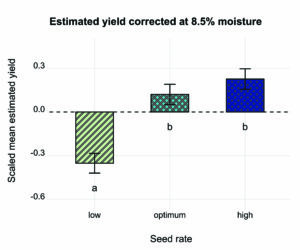Strategies to improve flea beetle control
KEY RESULT:
Landscape composition affected flea beetle abundance, as well as seeding rate, temperature, predator presence and the type of pest control option selected.
PROJECT TITLE, PRINCIPAL INVESTIGATOR:
“Integrated approaches for flea beetle control II: Incorporating the impacts of plant density, ground predators, and landscape-scale predictive models in the management of flea beetles in the Canadian Prairies,” Alejandro Costamagna, University of Manitoba, and collaborators
FUNDING:
AgriScience Program (Canola Cluster) under the Canadian Agricultural Partnership
PUBLISHED ARTICLES:
Read the full report on the Canola Research Hub.
Flea beetles are a major pest insect in canola every year, yet management has many knowledge gaps. This research addressed the gaps that potentially prevent efficient flea beetle management, including: the effects of plant density, the effects of stem feeding damage and the role of natural enemies in flea beetle management, as well as regional predictive models for flea beetle abundance and damage.
Between 2018 and 2022, researchers conducted 16 trials in Manitoba, Saskatchewan, Alberta-Peace River and Alberta-Lethbridge. Treatments were a combination of different seeding rates and flea beetle control methods. Seeding rates were low (3.5 kg/ha or 3 plants per square foot), optimum (7 kg/ha or 6 plants per square foot) and high (14 kg/ha or 12 plants per square foot).
Flea beetle control methods included fungicide-only treated seeds (i.e. control), insecticide and fungicide-treated seeds (i.e. seed), foliar insecticide spray at 25 per cent defoliation with fungicide-only treated seeds (i.e. foliar) and a weekly foliar insecticide spray with fungicide-only treated seeds (i.e. FB-free).
Results
- The seed treatments were more effective in reducing flea beetle defoliation than the foliar spray, which provided intermediate control compared to untreated plots.
- The FB-free treatment indicated that foliar and seed treatments did not completely prevent damage in Manitoba and Saskatchewan.
- Seeding rate had no effects on defoliation of the control, foliar and FB-free treatments, whereas increasing the seeding rate decreased canola defoliation for treated seeds.
- For all treatments, low-seeded plots were less attractive to flea beetles than high-seeded plots. The optimum-seeded plots had an intermediate effect in the control and foliar treatments.
- Higher seeding rates resulted in a lower number of flea beetles per plant (as the total number of beetles can disperse onto fewer numbers per plant when more plants are available). The optimum seeding rate had intermediate levels of flea beetles per plant in Manitoba and Peace River, while Lethbridge had higher and Saskatchewan had lower levels.
- Though no economic analysis was incorporated, higher seeding rates resulted in better yield, regardless of flea beetle control methods and across all regions.
- Less whole-plant damage occurred when ground beetles and spiders were present. In addition to eating flea beetles, the reduction in stem damage without a reduction in cotyledon damage prevalence may suggest a behavioral change of flea beetles moving up the plant to avoid predation.
- Both striped and crucifer flea beetles increased damaging activity with warmer temperatures, causing the most cotyledon damage at 28°C. Both species also damaged the underside of the cotyledon more than the upper side. There was no difference in amounts of damage between species.
- Large canola crops favoured flea beetle abundances at the field scale, but fields located in landscapes with higher proportion of non-canola crops showed lower infestation levels. Grass borders at large scales appeared to favour flea beetle abundances potentially by providing overwintering/dispersing sites, however, the opposite effect was observed at smaller scales. Higher edge density (indicating smaller fields and habitats in the landscape) and more woody habitats helped against flea beetle infestations most likely by acting as physical barriers against flea beetle movement and dispersal to canola.






